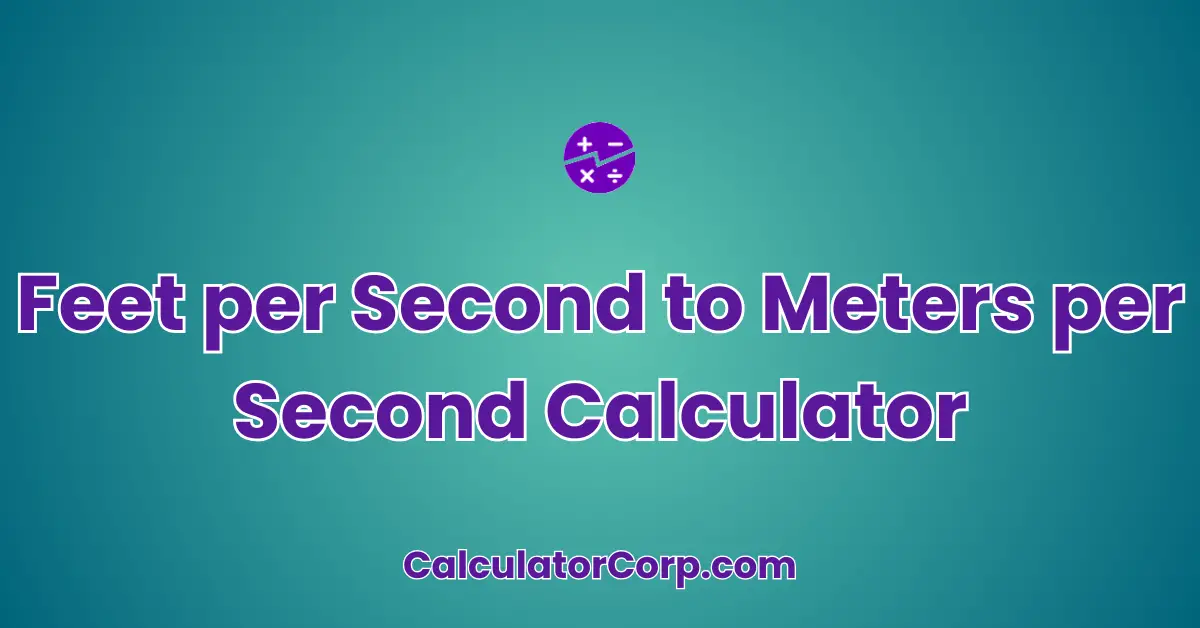The Feet per Second to Meters per Second calculator is a tool designed to aid you in converting speed measurements from feet per second (ft/s) to meters per second (m/s). This conversion is essential in various fields such as physics, engineering, and even everyday scenarios where speed calculation is necessary. As someone looking for precise measurements, this calculator serves your needs by providing quick and accurate conversions, eliminating the need for manual calculations.
Feet per Second to Meters per Second Calculator
Select a value from the dropdown or enter your own value to see the conversion to meters per second. (1 fps = 0.3048 m/s)
How to Use Feet per Second to Meters per Second Calculator?
Field Explanation: Begin by entering the speed in feet per second in the designated input field. Ensure the value is numerical and represents the speed accurately.
Result Interpretation: Once calculated, the result will display the equivalent speed in meters per second. For instance, if you enter 10 ft/s, the output will be 3.048 m/s.
Tips: Avoid entering non-numeric characters. If rounding is necessary, consider the degree of precision you need. For example, 3.048 might be rounded to 3.05 for simplicity.
Backend Formula for the Feet per Second to Meters per Second Calculator
The formula used in the calculator is straightforward: multiply the value in feet per second by 0.3048 to convert it to meters per second. This conversion factor stems from the precise length of a foot in meters.
Step-by-Step Breakdown: Start by identifying the input value in feet per second. Multiply this number by 0.3048. The result is the speed in meters per second.
Illustrative Example: For example, converting 20 ft/s to m/s involves multiplying 20 by 0.3048, resulting in 6.096 m/s.
Common Variations: While 0.3048 is standard, some scenarios may use alternative rounding methods. However, this factor remains universally accepted for precision purposes.
Step-by-Step Calculation Guide for the Feet per Second to Meters per Second Calculator
Detailed Steps with Examples: Begin by entering the speed in feet per second. The calculator then multiplies this by 0.3048 to provide a direct conversion.
User-Friendly Breakdown: This step ensures you understand that each feet per second is equivalent to 0.3048 meters per second, providing clarity on conversion.
Multiple Examples: For example, 5 ft/s converts to 1.524 m/s, while 15 ft/s converts to 4.572 m/s, showcasing the linear relationship.
Common Mistakes to Avoid: Ensure the input is accurate and numerical. Avoid assumptions about the conversion factor and validate the results for critical scenarios.
Real-Life Applications and Tips for Feet per Second to Meters per Second
Expanded Use Cases: This conversion is crucial for athletes calculating running speeds, engineers planning projects, or simply when comparing speeds in different measurement systems.
Short-Term vs. Long-Term Applications: Short-term, use it for immediate speed assessments. Long-term, apply it for project planning and forecasting.
Practical Tips: Ensure the data you input is accurate. Rounding results can offer convenience but may affect precision, so balance this based on your needs.
Feet per Second to Meters per Second Case Study Example
Expanded Fictional Scenario: Meet Alex, an engineer working on a project requiring speed calculations for machinery. Alex uses the calculator to convert speeds from feet per second to meters per second to align with project specifications.
Multiple Decision Points: Before finalizing plans, Alex uses the calculator to ensure all speed measurements are consistent, checking again after equipment changes to maintain accuracy.
Result Interpretation and Outcome: The precise conversions allow Alex to make informed decisions, optimizing the project for efficiency and safety.
Pros and Cons of Feet per Second to Meters per Second
List of Pros: This calculator saves time, ensuring fast, accurate conversions without manual calculations, enhancing your decision-making capabilities.
List of Cons: Over-reliance on the tool might lead to errors if the input is incorrect. Always verify critical calculations with additional methods when necessary.
Mitigating Drawbacks: Cross-reference results with other tools or expert consultations, especially in scenarios demanding high precision.
Example Calculations Table
| Feet per Second | Meters per Second |
|---|---|
| 1 | 0.305 |
| 10 | 3.048 |
| 50 | 15.240 |
| 100 | 30.480 |
| 500 | 152.400 |
Table Interpretation: The data illustrates a direct proportionality between feet per second and meters per second, emphasizing the straightforward nature of the conversion.
Glossary of Terms Related to Feet per Second to Meters per Second
Speed: The rate at which an object covers distance. For example, a car traveling at 60 mph.
Conversion Factor: A numerical value used to convert one unit of measurement to another; in this case, 0.3048 for feet to meters.
Precision: The degree to which repeated measurements under unchanged conditions show the same results.
Frequently Asked Questions (FAQs) about the Feet per Second to Meters per Second
What is the conversion factor used? The conversion factor is 0.3048, derived from the exact length of a foot in meters.
Why use this calculator? It provides quick, accurate conversions critical in fields requiring precise speed measurements without manual effort.
Can I rely solely on this tool? While it offers accurate results, always verify with additional resources in high-stakes scenarios.
How does rounding affect results? Rounding may simplify outputs but can reduce precision. Consider the context when deciding on rounding.
What if my result seems off? Double-check inputs and ensure no errors in entry. Re-calculate and consult other sources if necessary.
Further Reading and External Resources
- RapidTables: Feet per Second to Meter per Second Conversion – A detailed guide on speed conversions with additional information.
- UnitConverters.net: Speed Conversion – Offers a broader range of unit conversions for speed and other measurements.
- Engineering Toolbox: Speed Units Converter – Useful for engineers needing precise conversion data across various units.

